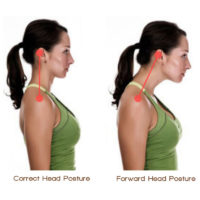
If you have headache, neck, and upper back problems, strengthening cervical flexors reduces pain. This is a key consideration in Upper Crossed Syndrome and Forward Head Posture generally.
Several muscle groups that flex the neck forward. At first, the most obvious ones are the SCM (Sterno-Cleido Mastoid) – plainly visible as “cords” in the front of the necks of some older, thinner people.
However, the most important ones, Longus Capitis and Longus Colli, are often missed. In fact, strengthening Cervical Flexors reduces pain in the neck, shoulders, and upper and lower back. But, these muscles are located deep in the neck, behind the esophagus and windpipe.
Strengthening them is a vital part of any neck, shoulder, or upper back rehabilitation program.
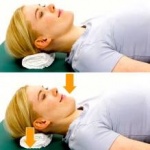 We recommend starting with a truly easy exercise that can be done laying down, seated or standing against a wall. We recommend laying down at first so that you can keep the rest of your spine straight and relaxed.
As with most of our self-care activities, we begin with the foundation of a good diaphragmatic breathing. Bring your attention to your breath and the combination of your diaphragm pulling down to allow air in and your transversus abdominis bracing against it.
We recommend starting with a truly easy exercise that can be done laying down, seated or standing against a wall. We recommend laying down at first so that you can keep the rest of your spine straight and relaxed.
As with most of our self-care activities, we begin with the foundation of a good diaphragmatic breathing. Bring your attention to your breath and the combination of your diaphragm pulling down to allow air in and your transversus abdominis bracing against it.
Neck Retraction With Chin Tuck
To initiate this movement, begin with slightly tucking the chin, then push your head straight back (down in this position) into the floor. Hold for one count.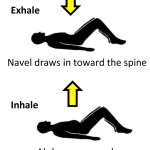 Check in with your lower and upper back - did you use those muscles too? Try again and make a conscious effort to use only your neck and avoid using your back muscles to assist. Hold the position for two counts and then a third time for three counts. Don't forget to breathe.
Check in with your lower and upper back - did you use those muscles too? Try again and make a conscious effort to use only your neck and avoid using your back muscles to assist. Hold the position for two counts and then a third time for three counts. Don't forget to breathe.
Building Strength and Stamina
Neck muscles are pretty delicate, so we are going to stop there. Over successive days you should increase the number of repetitions to from 3 to 10, increasing the hold time for each from 3-10 counts as well. Don't forget to breathe. Ultimately, 10 seconds, plus 9+8+7, etc. adds up to a pretty substantial exercise We are using repetitions to build strength and holding the position to build endurance. After all, these muscles help keep your head over your body all day! It may not seem like a worthwhile exercise, but strengthening cervical flexors reduces pain! It is worth the effort.Extra – Anatomy of Key Neck Muscles
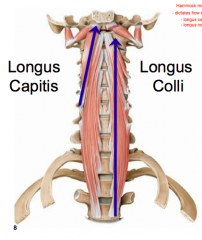 The primary flexor of your neck is a muscle called Longus Colli - Latin for long muscle of the neck. Its partner Longus Capitis is the muscle that tilts your head down, as in a nod. They are also called Deep Cervical Flexors. These muscles are located deep in the neck, behind the esophagus and windpipe.
An accident, such as whiplash, can injure these cervical flexors and inhibit them. Inhibited muscles don't function properly. When this happens, other related muscles step in to help.
The most common helpers are the SCM (Sterno-Cleido Mastoid) – plainly visible as “cords” in the front of the necks of some people. Other neck flexors, such as your scalenes, are not easy to see. When the SCM or scalenes are chronically engaged, they cause pain. They also prevent the deep cervical flexors from recovering and doing their job.
The primary flexor of your neck is a muscle called Longus Colli - Latin for long muscle of the neck. Its partner Longus Capitis is the muscle that tilts your head down, as in a nod. They are also called Deep Cervical Flexors. These muscles are located deep in the neck, behind the esophagus and windpipe.
An accident, such as whiplash, can injure these cervical flexors and inhibit them. Inhibited muscles don't function properly. When this happens, other related muscles step in to help.
The most common helpers are the SCM (Sterno-Cleido Mastoid) – plainly visible as “cords” in the front of the necks of some people. Other neck flexors, such as your scalenes, are not easy to see. When the SCM or scalenes are chronically engaged, they cause pain. They also prevent the deep cervical flexors from recovering and doing their job.
Structure
The Longus colli is situated on the anterior surface of the upper vertrabrae between the atlas and the third thoracic vertebra. It is broad in the middle, narrow and pointed at either end, and consists of three portions, a superior oblique, an inferior oblique, and a vertical.- The superior oblique portion arises from the transverse processes of the third, fourth, and fifth cervical vertebræ and, ascending obliquely with a medial inclination, is inserted by a narrow tendon into the anterior arch of the atlas.
- The inferior oblique portion, the smallest part of the muscle, arises from the front of the bodies of the first two or three thoracic vertebræ; and, ascending obliquely in a lateral direction, is inserted into the transverse processes of the fifth and sixth cervical vertebræ.
- The vertical portion arises, below, from the front of the bodies of the upper three thoracic and lower three cervical vertebræ, and is inserted into the front of the bodies of the second, third, and fourth cervical vertebræ.
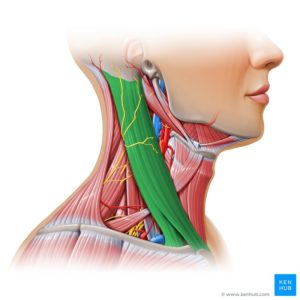 The sternocleidomastoid muscle is one of the largest and most superficial cervical muscles. The primary actions of the muscle are rotation of the head to the opposite side and flexion of the neck. The sternocleidomastoid is innervated by the accessory nerve.
It is given the name sternocleidomastoid because it originates from the top of the sternum (sterno-) and the clavicle (cleido-), and has an insertion at the mastoid process of the temporal bone of the skull.
The sternocleidomastoid muscle is one of the largest and most superficial cervical muscles. The primary actions of the muscle are rotation of the head to the opposite side and flexion of the neck. The sternocleidomastoid is innervated by the accessory nerve.
It is given the name sternocleidomastoid because it originates from the top of the sternum (sterno-) and the clavicle (cleido-), and has an insertion at the mastoid process of the temporal bone of the skull.
